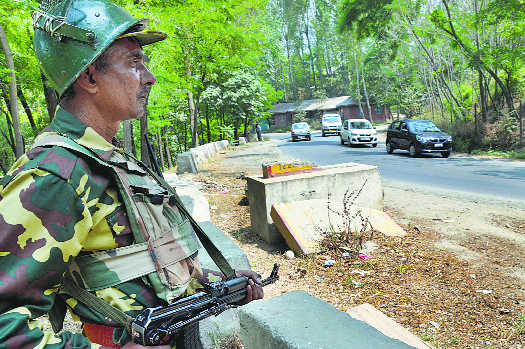
Restraint: Ceasefire proposed for second time in J&K. Tribune photo: Mohammad Amin War
Lt-Gen Syed Ata Hasnain (retd)
Ex-GOC of the Srinagar-based 15 Corps
In J&K's bleak security landscape through 2017-18, a unilateral ceasefire proposed by the state's mainstream parties was bound to be received with a mix of emotions, some happy and others involving concern, disquiet and a sense of foreboding. The term ceasefire is itself questionable because in sub-conventional operations, the accepted term is seizure of offensive operations (SOO) or, simply, restraint in operations.
Unilateral decisions of this kind are many times perceived as something which only the disadvantaged side looks to as a reprieve from a difficult operational situation it finds itself in. This is a flawed perception. While the almost daily incidents of killing in Kashmir have caused dismay, the proposal to restrain operations by the state is not such a simple issue. It needs much greater deliberation from two angles: first, the psychological messaging which arises from such a decision; and second, on the doability of the proposal.
Earlier ‘ceasefire’
In J&K, this is the second time that the issue has arisen, the first being then Prime Minister Atal Bihari Vajpayee's Ramzan 'ceasefire' of November, 2000. While the government may have for now not accepted the proposal, two models of this need to be kept in mind. The first is of Nagaland where such a decision resulted in a successful negotiation that has fructified into a yet-to-be-firmed-in settlement; it does need a reminder that in the North-East, the level of proxy and ideological support has mostly remained below threshold. The second is the Sri Lanka model where the LTTE went through many such arrangements with the army only to emerge stronger each time to fight back with renewed vigour.
Reports in Delhi indicated that intelligence agencies possibly favoured such a step and extracts from the Army Chief's interview with a mainstream newspaper were also being initially used to indicate the Army's favour for the same. The proposal needs a deeper analysis.
There is no doubt that the current situation is not reflective of any domination by the terrorists. Operation All Out has met unqualified success in terms of neutralisation of the armed cadres. Yet, the situation is not under full control because of the deep-set alienation which has forced the Kashmiri youth in particular to take to the streets, unmindful of their safety. A persistence of this attitude is dangerous and unpredictable. There also appears a spurt in recruitment to local terrorist ranks. The Durbar has just returned to the Valley and the month of Ramzan is approaching, the ending of which will nearly coincide with the commencement of the Amarnath Yatra. The Chief Minister's proposal did make sense from the timing and situation point of view, provided the powers-that-be are clear what they are aiming at. We have the experience of the Non-Initiation of Combat Operations (NICO) of 2000-01 in J&K and of the SOO in the North-East to go by and the institutional knowledge of the Army will always be handy.
Focused aim must
Any major decision in operations must have a focused aim — the necessity to allow things to calm and emotions stabilise. Yet it cannot allow a leeway for rebuilding terrorist capability and wherewithal. Restraint in such operations has to be a graded one, with nuances that will ensure both adequate control and sufficient freedom. The political community must have the chance to go back to the grassroots and engage with its constituencies. There has to be absence of violence. The spelling of saner narratives will then be possible. The one thing to guard against is disinformation and misinformation enabled by social media.
The naysayers need to understand that in the world of sub-conventional operations, ego must be shelved since there are no winners or losers against your own people; that is the notion with which the Army operates. A unilateral restraint in operations is no indicator of weakness. In fact, it is a display of confidence and the will to seek peace. The concept of execution must remain such that in the eventuality of failure, the return to operations must not witness greater terrorist capability.
Under such a decision, the Army does not go into rest and recuperation mode or back to its barracks. The challenge of execution is actually even greater than when operational freedom exists. Offensive operations are curbed (no cordon and search and no search and destroy operations) but open display of weapons by terrorists invites action. All defensive operations continue and this includes securing of roads and installations, area domination and display of the flag. There is no change in the execution of counter-infiltration at the LoC. The presumption is that terrorists, too, will refrain from striking, although all security precautions remain in place. The problem in execution arises when such a halt exists only against local terrorists. In end-2000, during the NICO period, the LeT conducted a dastardly but failed attempt to storm into Srinagar airport. With strength of foreign terrorists now much lower, this too can be overcome.
If giving peace a chance is the aim, then absence of an identified terrorist leadership is likely to militate against it. The engagement with the public will have to take the shape of 'awami sunwai', an experiment in direct engagement successfully conducted in 2011-12 to promote hope through interaction. For this, the political community and the administrators will have to take risks and step forward even as they receive flak and humiliation.
In a worse scenario, the exercise in restraint could just fail. With a professional army, return to operational mode will be immediate and a projection of moral ascendancy having been achieved through the restraint will not be unhelpful in the conduct of psychological operations.



























